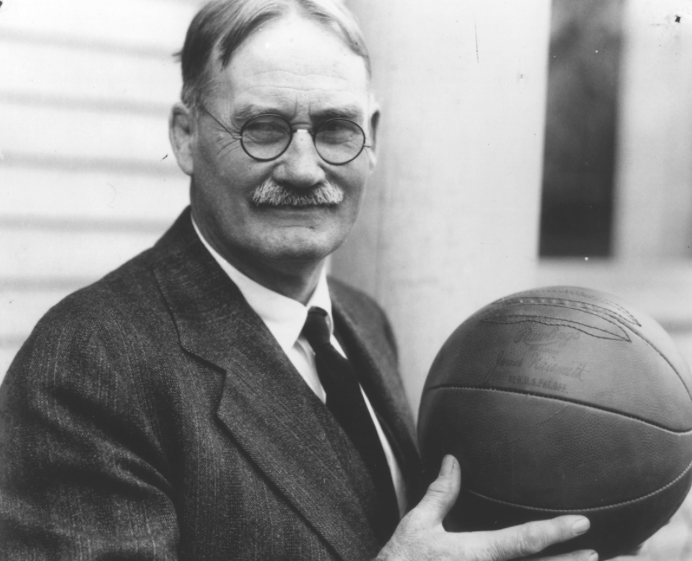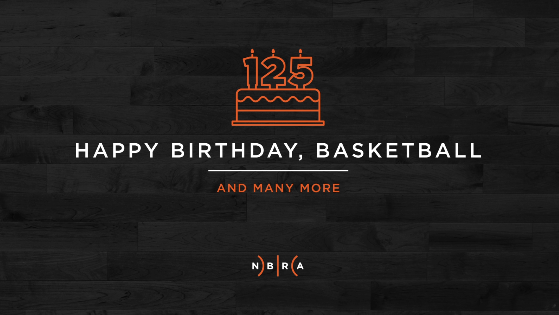 Source: http://unmistakablylawrence.com/explore/itineraries/basketball/
Source: http://unmistakablylawrence.com/explore/itineraries/basketball/
Today is a special day in the history of basketball. On this day, December 21st, in 1891, the first basketball game was played in Springfield, Massachusetts.
Created by Canadian-born Dr. James Naismith, basket ball, had 13 original rules. The sport has evolved and modified in many ways over the past 125 years, but today?s rules have the same fundamental principles as Naismith intended in 1891.
Dr. James Naismith earned his degree in Physical Education from McGill University before departing to America in 1890. Later that year, he enrolled at Springfield College in Massachusetts, known at the time as the YMCA Training School. During his second year of graduate school, Naismith attended a Psychology of Play seminar taught by Dr. Luther Halsey Gulick, the superintendent of physical education at the College. Gulick tasked the attendees with creating a non-violent game that could be played indoors during the cold winter months. The original intention of the new game was to keep restless students in shape in between the fall and spring sports seasons.

In the fall of 1891, after modifying several other sports including a childhood game called duck on a rock, basket ball was born. Originally, basket ball had 13 rules and was played with two peach baskets as goals. There was only 1 point scored in the first game in Springfield.
One of the biggest differences between Naismith?s game 125 years ago and basketball today is that the original game had no dribbling. Players had to throw the ball from the spot on which they caught it, allowing the man in motion catching the ball just a few steps. Another difference was that if either team committed three consecutive fouls, it counted as a ?goal? for the opponent. Although this rule no longer exists, if either team commits five fouls in a quarter, the offending team is in the penalty and the fouled team has the opportunity to shoot free throws.
Although, the game has greatly advanced ? now played in over 200 countries ? from its first days in 1891, the authenticity of Naismith?s original idea has endured. See the original 13 rules below:

1. The Ball may be thrown in any direction by one or both hands.
2. The ball may be batted in any direction with one or both hands (never with the fist).
3. A player cannot run with the ball. The player must throw it from the spot on which he catches it, allowance to be made for man who catches the ball when running, if he tries to stop.
4. The ball must be held by the hands; the arms or body must not be used for holding it.
5. No shouldering, holding, pushing, tripping, or striking in any way the person of an opponent shall be allowed; the first infringement of the rule by any player shall count as a foul, the second shall disqualify him until the next goal is made, or if there was evident intent to injure the person, for the whole game, no substitute allowed.
6. A foul is striking at the ball with the fist, violation of rules 3, 4, and such as described in rule 5.
7. If either side makes three consecutive fouls it shall count a goal for the opponents (consecutive means without the opponents in the meantime making a foul.)
8. A goal shall be made when the ball is thrown or batted from the grounds into the basket and stays there, providing those defending the goal do not touch or disturb the goal. If the ball rests on the edges, and the opponent moves the basket, it shall count as a goal.
9. When the ball goes out of bounds it shall be thrown into the field of play by the person first touching it. In case of a dispute the umpire shall throw it straight into the field. The thrower-in is allowed five seconds; if he holds it longer it shall go to the opponent. If any side persists in delaying the game, the umpire shall call a foul on that team.
10. The umpire shall be the judge of the men and shall note the fouls and notify the referee when three consecutive fouls have been made. He shall have the power to disqualify men according to rule 5.
11. The referee shall be the judge of the ball and shall decide when the ball is in play, in bounds, to which side it belongs, and shall keep the time. He shall decide when a goal has been made, and keep account of the goals, with any other duties that are usually performed by the referee.
12. The time shall be two 15-minute halves, with 5 minutes rest between.
13. The side making the most goals in that time shall be declared the winner. In case of a draw, the game may be by mutual agreement, be continued until another goal is made.



